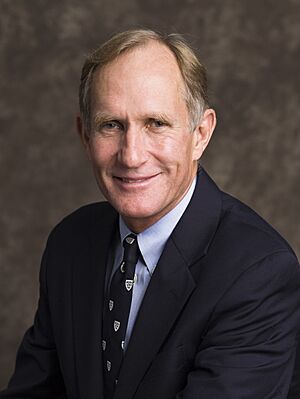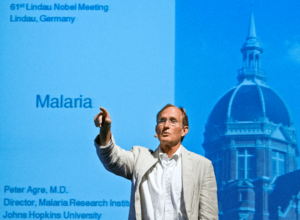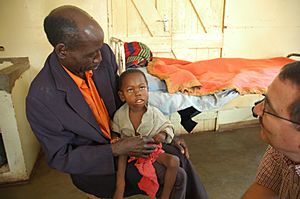Peter Agre facts for kids
Quick facts for kids
Peter Agre
|
|
|---|---|

Agre in 2003
|
|
| Born | January 30, 1949 Northfield, Minnesota, U.S.
|
| Alma mater | Augsburg College (BA) Johns Hopkins University (MD) |
| Known for | Aquaporins |
| Awards | Nobel Prize in Chemistry (2003) Bloomberg Distinguished Professorships (2014) |
| Scientific career | |
| Fields | Medicine Chemistry Biochemistry |
| Institutions | Johns Hopkins Malaria Research Institute Duke University Case Western Reserve |
Peter Agre (born January 30, 1949) is an American doctor and scientist who won the Nobel Prize. He is a professor at the Johns Hopkins Bloomberg School of Public Health and the Johns Hopkins School of Medicine. He is also the director of the Johns Hopkins Malaria Research Institute.
In 2003, Agre and another scientist, Roderick MacKinnon, shared the Nobel Prize in Chemistry. They won the prize for their discoveries about channels in cell membranes. Agre was honored for his discovery of aquaporins. Aquaporins are special proteins that act like tiny tunnels, allowing water molecules to move quickly in and out of our cells.
Agre has also been president of the American Association for the Advancement of Science (AAAS), where he became involved in science diplomacy, using science to build better relationships between countries.
Contents
Early Life and Education
Peter Agre was born in Northfield, Minnesota. He was the second of six children. His family background is Norwegian and Swedish. As a high school student, he took a camping trip through the Soviet Union, which made him fascinated with world travel.
Agre wasn't always a focused student. He became interested in science because of his father, who was a college chemistry professor. After high school, he earned a degree in Chemistry from Augsburg University. He then went on to get his medical degree from the Johns Hopkins School of Medicine in 1974.
After medical school, he trained in hospitals and later returned to Johns Hopkins in 1981 to do research. He became a full professor in 1992. He later worked at Duke University Medical Center before returning to Johns Hopkins in 2008 to lead the Malaria Research Institute.
Personal Life
Agre and his wife, Mary, have been married since 1975. They have four children and several grandchildren. Agre is an Eagle Scout, a top honor in the Boy Scouts. His son and two of his brothers are also Eagle Scouts.
He loves outdoor activities like canoeing in the arctic and cross-country skiing. He has even completed a 60-mile ski race in Sweden five times. In 2012, Agre was diagnosed with Parkinson's disease, which has caused him to slow down his activities.
Agre is known for being humble and down-to-earth. He once told a magazine, "I identify more with Huckleberry Finn than with Albert Einstein."
The Discovery of Aquaporins
In the 1980s, while studying something else, Agre's research team made an accidental discovery. They found a new protein in the membrane of red blood cells. This protein was also found in kidney cells and was similar to proteins found in fruit flies, plants, and bacteria.
No one knew what this protein did. Agre asked a former professor for advice. The professor suggested it might be the long-sought-after "water channel." For years, scientists had wondered how water could move so quickly across cell membranes.
How Aquaporins Work
To test this idea, Agre's team did an experiment. They put the protein's genetic code into frog eggs. The frog eggs, which normally sit in fresh water just fine, suddenly started absorbing water so fast that they swelled up and burst! This proved that the protein was indeed a water channel.
Agre named the protein aquaporin-1 (or AQP1). He called aquaporins "the plumbing system for cells." He explained that every cell is mostly water, and this water needs to move in and out in an organized way. Aquaporins make this rapid movement possible.
Scientists have since found 12 different types of aquaporins in the human body. They are essential for making cerebrospinal fluid (which protects the brain), tears, sweat, and saliva. They also help keep our airways moist and allow our kidneys to work properly.
Winning the Nobel Prize
In October 2003, Agre was asleep when he got a phone call at 5:30 in the morning from Stockholm, Sweden. He was told that he had won the Nobel Prize in Chemistry for his discovery of aquaporins.
When his mother heard the news, her funny response was, "That's very nice but don't let it go to his head."
Fighting Malaria
Agre has always been interested in diseases that affect people in developing countries. He became the Director of the Johns Hopkins Malaria Research Institute (JHMRI) in 2008. Malaria is a serious disease spread by mosquitoes.
The institute has 20 teams of scientists working on different ways to fight malaria. They are trying to:
- Develop mosquitoes that can't spread the disease.
- Create new vaccines to prevent malaria.
- Find new medicines to treat people who are sick.
A big part of JHMRI's work happens in Africa. They have a research center in a rural part of southern Zambia. There, scientists from Johns Hopkins and Africa work together to study malaria. Thanks to new medicines and insecticide-treated bed nets, the number of malaria cases in young children in that area has dropped by 96%.
Science Diplomacy
When Agre was president of the AAAS, he became a "science diplomat." This means he used science as a way to build friendships and understanding between the United States and other countries, especially those with tense relationships. The goal was to work together on peaceful science projects to help reduce tensions.
Cuba
Agre led a group of American scientists on a visit to Cuba. They visited the Cuban Academy of Sciences and other top research centers. He even met with the country's leader, Fidel Castro, to talk about science and health care. These visits helped to restart scientific friendships between the two countries.
North Korea
In 2009, Agre led a team of scientists on a rare visit to North Korea, a country that is very isolated from the rest of the world. They visited universities and research centers, meeting with North Korean scientists who had never met an American before. They talked about working together on projects like developing new medicines and improving farming.
He also visited the Pyongyang University of Science and Technology (PUST), the only university in North Korea where classes are taught in English.
Other Diplomatic Visits
Agre also led science diplomacy trips to Myanmar (also known as Burma) and Iran. In each country, the goal was to open doors for scientific cooperation and build positive relationships.
Political and Social Activism
Agre believes that scientists should be involved in government and society. He was a founding member of a group called Scientists and Engineers for Change.
In 2007, he thought about running for the U.S. Senate in his home state of Minnesota. He wanted to bring a scientist's point of view to the government. He decided not to run because it would have meant stopping his important research and humanitarian work.
He has also spoken out on important issues like climate change. In 2015, he was one of 76 Nobel Prize winners who signed a declaration urging world leaders to take action on climate change.
See also
 In Spanish: Peter Agre para niños
In Spanish: Peter Agre para niños
- Roderick MacKinnon
- Gheorghe Benga




